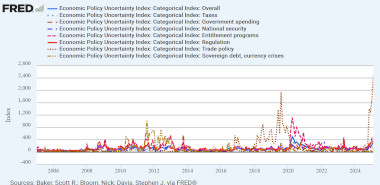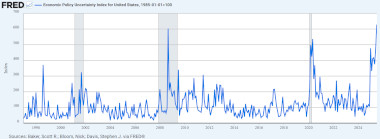July 8, 2025
On April 2 U.S. President Donald Trump declared a 'Liberation Day' by introducing tariffs on nearly all imports to the United States.
I adred to predict:
The 'invisible hand' of the markets will respond to Trump's moves by showing him a very visible finger.
The following days confirmed my take.
The tariff rates Trump announced were basically picked from hot air. The whole idea behind them were based on the weird theories of Steve Miran, the Chairman of Trump's President Council of Economic Advisors. They did not make sense.
By April 9 the markets hit back:
Treasury yields spiked on Wednesday as investors bailed out of what has been perceived as the world's safest instrument on expectations of crumbling foreign demand as tariffs take effect.
...
Yields settled down after China called for dialogue with the U.S. on trade, and then moved right back near the highs of the day after China said it was increasing its tariffs on the U.S. to 84%.
...
"Something has broken tonight in the bond market. We are seeing a disorderly liquidation," said Jim Bianco, president and macro strategist at Bianco Research.
Shortly thereafter Trump had to pull back ( archived):
The economic turmoil, particularly a rapid rise in government bond yields, caused Mr. Trump to blink on Wednesday afternoon and pause his "reciprocal" tariffs for most countries for the next 90 days, according to four people with direct knowledge of the president's decision.
Trump's unsteadiness on tariffs increased the uncertainty of economic decisions. Uncertainty is a poison, suppressing real economic activities.
The Federal Reserve Bank St. Louis produces hundreds of economic statistics. It includes several which are measuring uncertainty:

That FRED graph only included February. The doubt about Trump's economic policies had pushed it that high. The consequences of his tariff games were not yet visible.
Here is the current FRED overview graph of economic uncertainty. The index has reached a new record high:

When Trump had pulled back and announced his 90 days pause on tariffs, he and his advisors were hopeful that other countries would come to negotiate:
PETER NAVARRO:
...
So that's what we set, knowing full well, knowing full well that a lot of countries would come right to us and want a bargain. We've got 90 deals in 90 days possibly pending here.
Up to today, two days before the 90 day pause on tariffs expires, no trade deal was done. There are three new 'framework agreements' - with the UK, Vietnam, and China - which are more or less just letter's of intent but not agreements.
With the tariff pause ending, and no trade deals done, the Trump administration is forced to extend its tariff pause:
Treasury Secretary Scott Bessent said Sunday that the U.S. will revert to steep country-by-country tariff rates at the beginning of August, weeks after the tariff rate pause is set to expire.
...
CNN host Dana Bash responded to Bessent on Sunday, saying, "There's basically a new deadline," prompting Bessent to push back.
"It's not a new deadline. We are saying this is when it's happening," Bessent said. "If you want to speed things up, have at it. If you want to go back to the old rate, that's your choice."
On Friday, Trump, too, referred to an Aug. 1 deadline, raising questions about whether the July 9 deadline still stands.
The Trump administration is also moving the goalposts. Instead of negotiating trade agreements with individual countries the administration will just send out letters of, so far, unknown content:
Trump said Friday that the administration would start sending letters to countries, adding, "I think by the 9th they'll be fully covered."
"They'll range in value from maybe 60% or 70% tariffs to 10% and 20% tariffs, but they're going to be starting to go out sometime tomorrow," Trump said overnight on Friday. "We've done the final form, and it's basically going to explain what the countries are going to be paying in tariffs."
Trump said in a Truth Social post late Sunday evening that tariff letters would be delivered starting at noon on Monday.
There is only one country who's people will have to pay those tariffs and the is the U.S. itself.
There is little reason for other countries to react in any other way to the U.S. than by imposing symmetrical tariff measures. For many of them U.S. markets are no longer important enough. That is why most countries have simply ignored the matter:
Bessent also said Sunday that "many of these countries never even contacted us."
The whole Trump strategy of imposing tariffs to regain industrial activity and to impose its political aims on other countries have failed. China and the EU, the U.S. biggest trade partners, have not flinched. Others have followed their example.
Meanwhile the damage imposed by heightened trade uncertainty continues to accumulate. People are already paying higher prices.
A year from now, when the 2026 midterm elections come up, the damage from tariffs will be what really matters.
Reprinted with permission from Moon of Alabama.